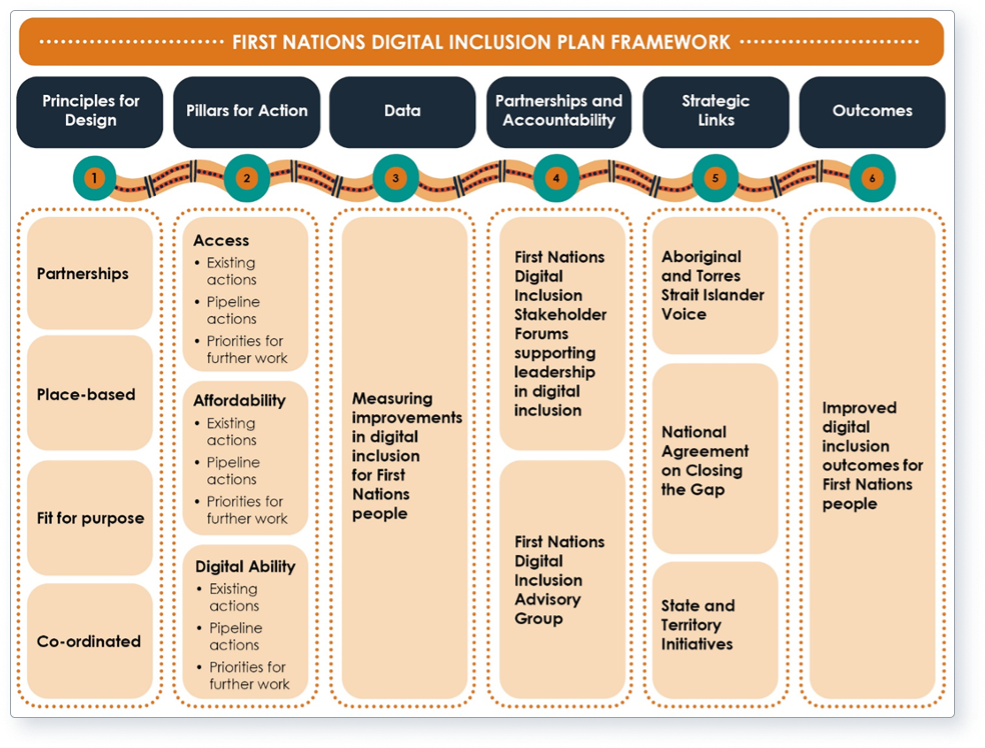
The First Nations Digital Inclusion Plan (2023-26)
In July this year, the Australian Government released the First Nations Digital Inclusion . The plan aims to close the digital inclusion gap between Indigenous and non-Indigenous Australians.
The plan focuses on three areas:
- Access
- Affordability
- Digital ability
The focus is on regional and rural Indigenous communities, however benefits will also be felt by Indigenous people living in urban areas.
The image below, taken from the First Nations Digital Inclusion , provides a visual overview of the plan’s strategic framework.
Image reproduced under Creative Commons Attribution 4.0 International licence (CC BY , © Commonwealth of Australia, National Indigenous Australians Agency, First Nations Digital Inclusion Plan – July 2023
Access
Access focuses on providing reliable, high-speed internet, and acknowledges the strong preference for mobile services. The plan considers access across infrastructure, connectivity literacy, and access to critical services.
The plan highlights existing government and non-government programs and investments such as:
- Regional Connectivity
- Mobile Black Spot
- Regional Tech
- School Students Broadband
- Telstra’s investment in the national mobile network
- Talking Telco
- My Health
Priorities for ‘access’ in the future
Looking forward, in terms of access the Plan identifies the following areas for improvement:
- Improved connectivity planning for Indigenous communities
- Development of regional technical support programs and tech support tailored to Indigenous people
- Designing government digital services to address inclusion issues
Affordability
Affordability looks at financial barriers for digital services, including connection, data and devices.
The plan highlights existing government and non-government programs and investments such as:
- Commonwealth Telephone
- Communities in Isolation
- The Smith Family’s Digital Access
- Telstra’s free calls from payphones and free Wi-Fi
- Be Connected
- Indigenous Knowledge Centres
- Adobe’s donation of software product licences to Indigenous communities
Priorities for ‘affordability’ in the future
Looking forward, in terms of ‘affordability’ the Plan identifies the following areas for improvement:
- Introducing unmetered data for access to critical services
- Public Wi-Fi internet services
- Improved access to affordable digital devices in regional and remote Indigenous communities
Digital ability
Digital ability looks at ensuring Indigenous people have the skills and confidence to access digital services effectively and safely.
The plan highlights existing government and non-government programs and investments such as:
- Be Connected
- Foundation Skills for Your Future Remote Community Pilots
- Your Online Journey
- The Indigenous Digital Health Workforce Initiative
- Mobile My
- Digital Work and Study
- Digital Skills Cadetship
- Healthy Country
- Be Deadly
- Online Safety Grants
Priorities for ‘digital ability’ in the future
Looking forward, in terms of ‘digital ability’ the Plan identifies the following areas for improvement:
- Support for community-led digital literacy
- Incorporating the needs of Indigenous Australians into the digital skills agenda
- Support for Indigenous people pursuing careers in digital technology
- Design online safety tools with Indigenous people and communities
Salsa Digital’s take
With Australia’s Voice referendum just around the corner, now is a good time to review and highlight the First Nations Digital Inclusion . The Plan is an important part in Australia’s long-term digital strategy and our strategy for closing the gap between Indigenous Australians and non-Indigenous Australians. While much work has already been done in this area, a formal plan like the First Nations Digital Inclusion Plan helps to focus initiatives and hopefully provide better outcomes for our First Nations people, especially those in remote and rural areas.
Salsa supports the First Nations Digital Inclusion and we’ve also developed our own Reconciliation Action Plan (RAP). Salsa’s RAP demonstrates our commitment to reconciliation, increasing economic equity and supporting First Nations self-determination.
More about the First Nations Digital Inclusion Plan
The First Nations Digital Inclusion Plan was developed by the National Indigenous Australians (NIAA) with support from the Department of Infrastructure, Transport, Regional Development and .
It’s part of the Target 17 of the National Agreement on Closing the : “by 2026 Aboriginal and Torres Strait Islander people have equal levels of digital inclusion.”
The plan was developed in consultation with First Nations organisations and communities.

